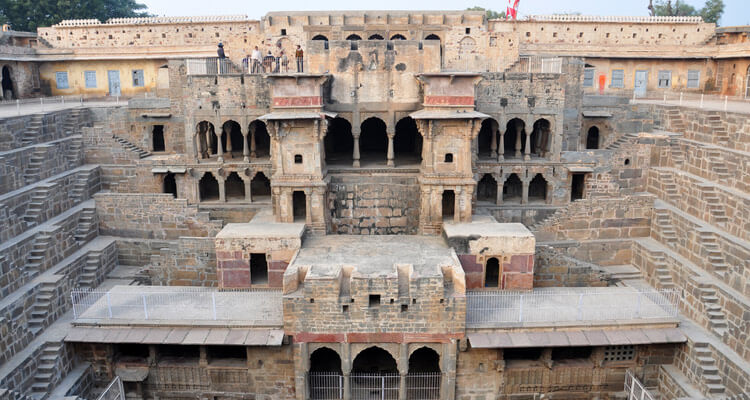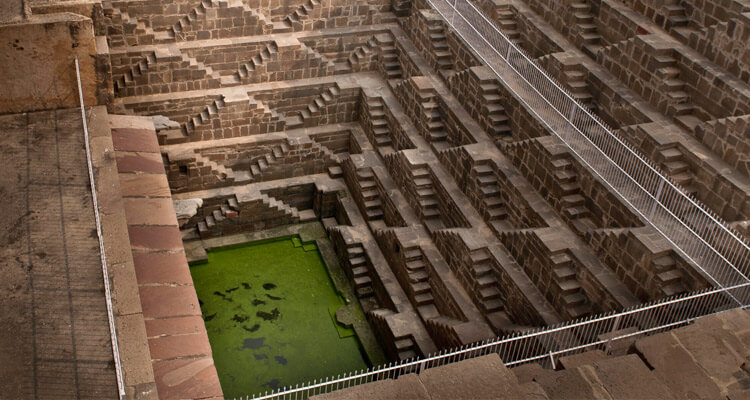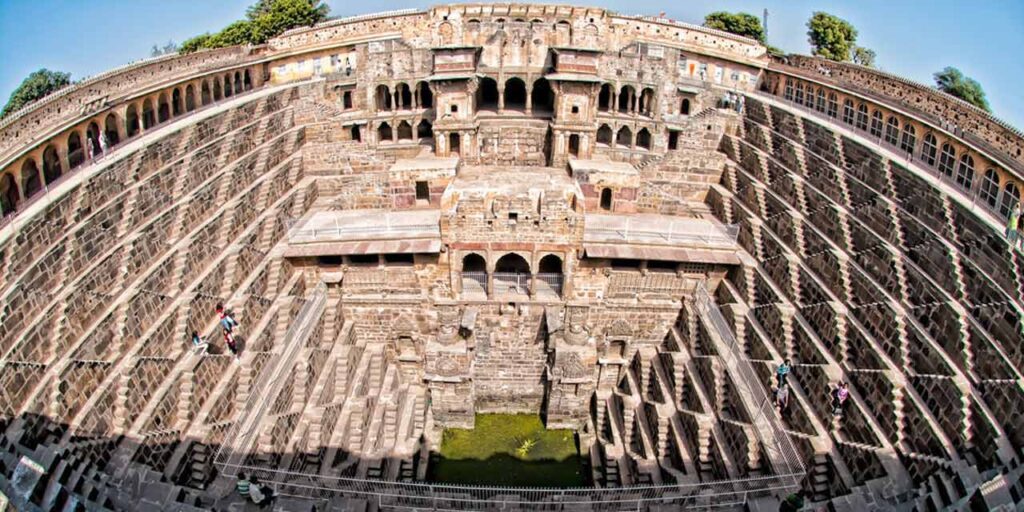The Abhaneri Step Well, popularly known as Chand Baori, is one of the most fascinating architectural wonders of Rajasthan. Located in the small village of Abhaneri, around 90 km from Jaipur, this historic stepwell is considered one of the deepest and largest stepwells in the world.

Built over a thousand years ago, Chand Baori stands as a symbol of ancient Indian engineering and craftsmanship, designed to conserve water in the arid climate of Rajasthan. With its 3,500 perfectly symmetrical steps arranged across 13 levels, the structure forms a mesmerizing geometric pattern that continues to attract travelers, photographers, and historians from across the globe.
Apart from its functional use as a water reservoir, the stepwell was also a social gathering place for villagers. Today, Chand Baori is not just a historical site but also a cultural landmark, frequently featured in movies, documentaries, and travel journals.
History of Abhaneri Step Well (Chand Baori)
The Abhaneri Step Well, also known as Chand Baori, was built in the 9th century by King Chanda of the Nikumbha Dynasty. Located in the village of Abhaneri (originally called Abha Nagari, meaning “city of brightness”), the stepwell reflects the ingenuity of ancient Rajasthani architecture in addressing water scarcity.
During that era, Rajasthan’s desert climate made water conservation a necessity. Chand Baori was constructed not only to store rainwater but also to provide a cool retreat during scorching summers. Its unique design allowed villagers to descend through 3,500 narrow steps across 13 stories to fetch water, even when the water level was low.
The stepwell also played a cultural role, as it was built near the Harshat Mata Temple, symbolizing the connection between water and fertility in Hindu tradition. Over centuries, it became a center of community life, where locals gathered for festivals, rituals, and daily activities.
Today, Chand Baori stands as one of the oldest and most iconic stepwells in India, admired for its historical significance and architectural brilliance.
Architecture & Design of Chand Baori
The Chand Baori stepwell is a masterpiece of symmetry and precision, showcasing the brilliance of ancient Indian engineering. With a depth of about 20 meters (65 feet), it is considered one of the deepest stepwells in the world.
The structure features 3,500 narrow steps arranged in a perfect geometric pattern across 13 levels, forming a mesmerizing crisscross design. The steps are so precisely aligned that they create a stunning visual effect, making Chand Baori a favorite subject for photographers and architecture lovers.

Unlike many stepwells that were purely functional, Chand Baori combines practicality with aesthetics. The wide open square at the top narrows as it descends, ensuring water conservation while keeping the base naturally cooler by almost 5–6 degrees lower than the outside temperature.
On one side of the stepwell stands a multi-storied pavilion with carved balconies and galleries, once used by the royal family and priests during rituals. This blend of Hindu and Mughal architectural influences gives Chand Baori its distinctive charm.
The design was not just about storing water, it was about creating a community space, a retreat during summer, and a reflection of the artistic vision of Rajasthan’s rulers.
Mythology & Stories of Chand Baori
Like many ancient Indian monuments, the Chand Baori stepwell is not only admired for its architecture but also shrouded in myths and legends that add to its mystery.

Legend of the Spirits
Local folklore suggests that Chand Baori was built by ghosts overnight, as the precision and scale of the construction seemed impossible for humans alone in that era. This legend makes the stepwell one of the most intriguing sites in Rajasthan.
Link with Harshat Mata Temple
The stepwell lies next to the Harshat Mata Temple, dedicated to the goddess of joy and happiness. According to belief, the water stored in Chand Baori was considered sacred and used for religious rituals in the temple. This symbolic connection highlights the importance of water as a divine element in Hindu tradition.
Chand Baori in Popular Culture
The mystique of Chand Baori has made it a backdrop for several movies and documentaries. Films like The Dark Knight Rises, Bhool Bhulaiyaa, and Paheli have featured its unique architecture, introducing it to a global audience.
These stories and myths give Chand Baori a cultural and spiritual identity that goes beyond its role as a water reservoir. It is not just a stepwell, it is a monument where history, faith, and folklore meet.
Also Check: Panna Meena ka Kund
Abhaneri Step Well Timings & Opening Hours
The Abhaneri Step Well (Chand Baori) is open daily, welcoming tourists, history enthusiasts, and photographers throughout the year. Being a protected heritage site, it follows fixed visiting hours.
- Opening Time: 8:00 AM
- Closing Time: 6:00 PM
- Open Days: Monday to Sunday (7 days a week)
Best Time of Day to Visit
- Morning (8:00 – 11:00 AM): Perfect for photography with soft sunlight highlighting the geometric patterns of the steps.
- Late Afternoon (4:00 – 6:00 PM): A great time to enjoy cooler weather and fewer crowds.
Seasonal Best Time
The ideal season to explore Chand Baori is October to March, when Jaipur and surrounding areas enjoy pleasant weather. Summers (April–June) can be extremely hot, while monsoons (July–September) may make the steps slippery.
Whether you’re on a Jaipur day trip or planning a cultural Rajasthan tour, knowing the Abhaneri Step Well timings ensures you get the most out of your visit.
Abhaneri Step Well Ticket Price
Visiting the Abhaneri Step Well (Chand Baori) is an affordable and rewarding experience, as it is maintained as a protected heritage monument. The entry fee structure is simple and accessible for both domestic and international travelers.
- Indian Visitors: ₹25 per person
- Foreign Tourists: ₹200 per person
- Children (below 15 years): Free entry
- Camera Charges: Still photography is generally free, but professional DSLR/video shooting may require special permission from the Archaeological Survey of India (ASI).
Travel Tip
Since Chand Baori is located in the village of Abhaneri, combine your visit with the Harshat Mata Temple, located right next to the stepwell, which has no separate entry fee. Many tourists also include Chand Baori as a stopover on the Jaipur–Agra highway tours.
This makes the Chand Baori ticket price one of the most budget-friendly heritage site experiences in Rajasthan.
Distance & How to Reach Abhaneri Step Well (Chand Baori)
The Abhaneri Step Well, also known as Chand Baori, is located in Abhaneri village, Dausa district, Rajasthan. It lies on the Jaipur–Agra highway (NH21), making it a convenient stopover for travelers visiting between the two cities.
Location: Google Map
Distance from Major Cities
- Jaipur to Abhaneri Step Well: ~95 km (approx. 2 hours by road)
- Agra to Abhaneri Step Well: ~165 km (approx. 3.5 hours by road)
- Delhi to Abhaneri Step Well: ~260 km (approx. 5–6 hours by road)
How to Reach
- By Road: The easiest way is to hire a cab/taxi or drive via NH21. Buses between Jaipur and Agra also stop near Dausa.
- By Train: The nearest railway station is Bandikui Junction (about 8 km away), well-connected to Jaipur and Delhi.
- By Air: The closest airport is Jaipur International Airport, about 90 km from Abhaneri.
Travel Directions
Most tourists prefer to include Chand Baori Abhaneri as part of a Jaipur–Agra day tour. Local guides are available at the site to enhance your visit with stories and history.
Things to See Around Abhaneri Village
A visit to the Abhaneri Step Well (Chand Baori) is not just about admiring the stepwell itself, there are several interesting attractions and experiences nearby that add depth to your trip.
Harshat Mata Temple
Located right next to Chand Baori, the Harshat Mata Temple is dedicated to the goddess of joy and happiness. Though partially in ruins, the temple’s intricate stone carvings and sculptures reflect the artistry of the 9th–10th century. Many locals believe that the water in Chand Baori was considered sacred and used for rituals here.
Abhaneri Village Culture
The village of Abhaneri offers a glimpse into rural Rajasthan life. From traditional mud houses to local handicrafts, it’s a cultural experience worth exploring. Tourists often enjoy short walks through the lanes to connect with local artisans and villagers.
Bollywood & Hollywood Connection
Chand Baori’s unique design has made it a filming location for several movies:
- The Dark Knight Rises (Hollywood)
- Bhool Bhulaiyaa (Bollywood)
- Paheli (Bollywood)
This connection has made the stepwell internationally famous, drawing movie buffs along with history enthusiasts.
Best Time to Visit Chand Baori, Abhaneri
The best time to visit Abhaneri Step Well (Chand Baori) depends on both the season and the time of day, as Rajasthan’s climate can be extreme.
Seasonal Best Time
- October to March (Winter): The most pleasant season for exploring Chand Baori. Temperatures range from 10°C to 25°C, making sightseeing comfortable.
- April to June (Summer): Rajasthan faces scorching heat with temperatures reaching up to 45°C. If visiting in summer, plan your trip early morning or late evening.
- July to September (Monsoon): Moderate rainfall brings greenery and cooler weather, but the steps may become slippery, so extra care is required.
Best Time of Day
- Morning (8:00 AM – 11:00 AM): Perfect for photography, with sunlight highlighting the geometric step patterns.
- Late Afternoon (4:00 PM – 6:00 PM): A pleasant time to visit before closing, when the weather is cooler and crowds are thinner.
Overall, the winter months and early mornings are the most recommended for enjoying the beauty of Chand Baori without weather discomfort.
FAQ about Abhaneri Step Well (Chand Baori)
Where is Abhaneri Step Well located?
Abhaneri Step Well, also known as Chand Baori, is located in Abhaneri village, Dausa district, Rajasthan. It is about 95 km from Jaipur on the Jaipur–Agra highway.
What is Chand Baori famous for?
Chand Baori is famous for being one of the largest and deepest stepwells in the world, with 3,500 steps across 13 stories, and its intricate geometric design.
What are the timings of Abhaneri Step Well?
The stepwell is open daily from 8:00 AM to 6:00 PM. Morning and late afternoon are the best times to visit for photography and cooler weather.
What is the entry fee for Chand Baori?
The entry fee for Indians is ₹25, while foreign tourists pay ₹200. Children under 15 years have free entry. Camera charges may apply for professional shoots.
How far is Abhaneri Step Well from Jaipur?
The stepwell is about 95 km from Jaipur, taking approximately 2 hours by road. The nearest railway station is Bandikui Junction (8 km).
What is the history of Chand Baori?
Chand Baori was built in the 9th century by King Chanda of the Nikumbha dynasty. It served as a water reservoir and community gathering place in the arid climate of Rajasthan.
Is Chand Baori featured in movies?
Yes, Chand Baori has been featured in both Bollywood and Hollywood films, including The Dark Knight Rises, Bhool Bhulaiyaa, and Paheli.
What is the best time to visit Chand Baori, Abhaneri?
The best season is October to March (winter months), when the weather is pleasant. The best time of day is early morning or late afternoon for a comfortable experience.
The Abhaneri Step Well (Chand Baori) is more than just a historic monument, it is a true symbol of Rajasthan’s architectural brilliance, cultural heritage, and engineering genius. Built over a thousand years ago, this stepwell continues to mesmerize visitors with its 3,500 steps, geometric symmetry, and fascinating legends.
From serving as a vital source of water in the desert to becoming a center of community life and a backdrop for world-famous films, Chand Baori has stood the test of time. Its proximity to Jaipur and its location along the Jaipur–Agra highway make it a perfect stop for history lovers, photographers, and cultural explorers.
Whether you are drawn by its history, myths, architecture, or scenic beauty, a visit to Abhaneri Chand Baori is an unforgettable experience that offers a glimpse into India’s rich past and timeless artistry.
